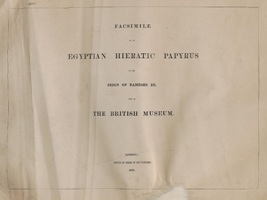| Main » Ad Board » ДРЕВЕН ЕГИПЕТ И АФРИКА » Литература |
| 18.09.2019, 12:15 | |
Големият Папирус Харис (pHarris I) e най-големият цялостен древноегипетски папирус достигнал до нас. Дълъг е 41 метра и съдържа 1500 реда текст, изписани с йератическо писмо. Открит е в гробница около Мединет Абу и е закупен от колекционера Антъни Чарлз Харис (1790-1869) през 1855 г. От 1872 г. е в колекцията на Британския Музей. - на древноегипетски език (йератическо писмо) и английски език, от HEIDI (Digital library of Heidelberg University), формат PDF.Сваляне с ляв бутон (downloading by left button) и после през бутона Download. - на древноегипетски език (йератическо писмо) и английски език, от Meretseger Books, формат PDF.Сваляне с ляв бутон (downloading by left button) и после през бутона стрелка надолу/after by down arrow button..
| |
| Views: 2000 | Placed till: 18.10.2024 | Rating: 0.0/0 | |

